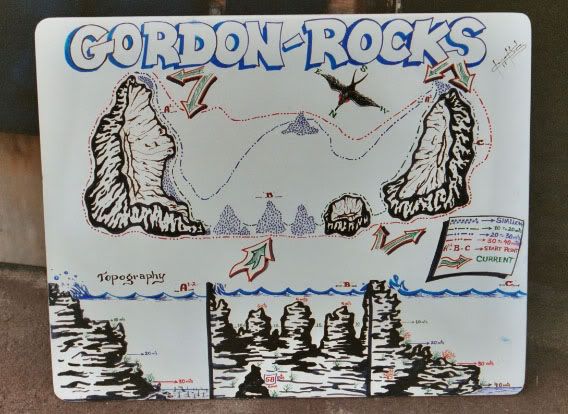These currents are no different than the lateral (or sideways) currents you likely have experienced in previous dives. The added problem presented with these currents that can change your "altitude" (depth) in the water column? They can easily mess up your dive profile, your Nitrogen loading, possibly lung expansion barotrauma and a host of other related DCI issues. Bouncing up and down rapidly is never a good idea.
Search for a lateral (sideways) route of escape. Get away from (or closer to) the rock wall that this flow of water is cascading over- the most common. Water works no differently than air currents over a mountaintop. Ever see a glider working the peaks? It's all about "Laminar Flow"
And/or Kick like mad up-wards, judicious taps of air into your BC.
Roll "Act Decisively" into that cascade of multi-tasking.
Be ready to negate, fine tune, or flat-out reverse these adjustments... at an equally fast decision rate.
"Handling it" is nowhere near as difficult as recognizing it.
Being aware of the situation is the first step, and that is very difficult for most of us at early stages of diving, times when we are so engrossed in the physical act that we are only dimply aware of our surroundings. This is so insidious, that you simply can't understand how much you are missing until years into your dive career.
I utilize several methods to recognize downwelling/upwellings.
The first and most obvious- your change in the water column relative to fixed objects... rocks, wall, wrecks.
Your change in relation to other moving objects might also be a good clue... check your depth gauge... but don't stare at it.
Are the divers up ahead doing something erratically different, something unexpected? How are the fish positioned in the water column? Are they swimming upwards into an invisible waterfall?
Later in diving careers will come the ability to sense other, less obvious signs. Are the bubbles being made around me acting differently? Are the soft Corals and/or Plants moving a certain way? Are you noticing a change in lighting?
You may be able, and you may learn to sense fairly minute variations in depth through your sinuses or with subtle mask squeeze.
In that Galapagos diving is centered around submerged remnants of volcanic cones, each various dive site might have multiple "dive paths" that will be selected by your DM, using his experience and after some quick measurements. Here are four different dives (note the colored dotted lines), all on one site:
At this particular dives site, a long ago volcano eroding away, as you dive through the very center of it, I have had heavy downwelling appear "out of nowhere" any number of times... no nearby wall that would be diverting flow, nothing apparent, just... WHAM! At 60fsw and then at the sand bottom at 100+ if you aren't watching. Not necessarily life threatening in this case, but it will cut your dive awfully short~ forcing you to make a controlled and orderly blue water ascent and be picked up in the center of the crater, versus at the far edge.
Talk to your DM. Learn the hand sign that he may use to advise you of upcoming current issues.
Anyone else have any thoughts?





